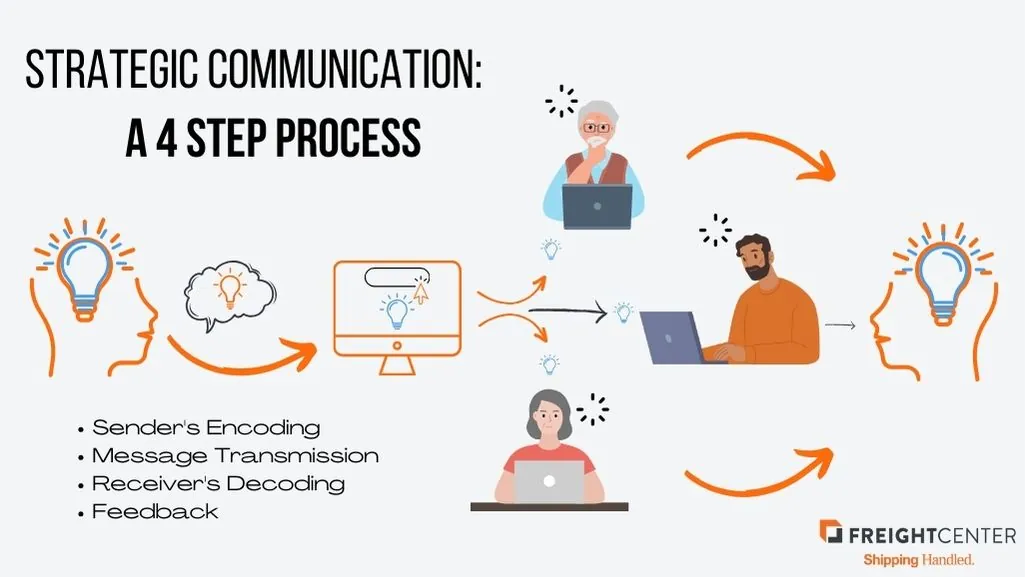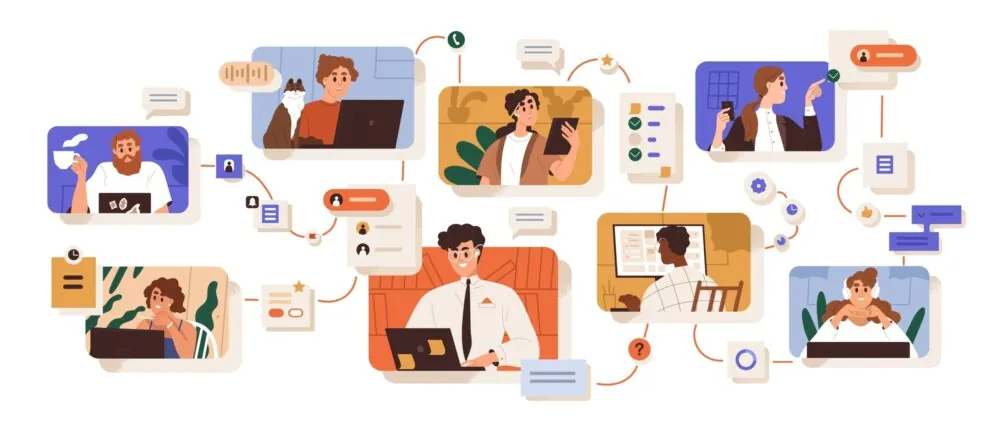What is Strategic Communication?

The definition of communication is the process by which infomation, news, or knowledge is passed or exchanged between the “sender” and the “reciever”. The individuals involved in communication can range from two people engaging- known as Interpersonal Communication, to Group Communication, and to Client Communication. In fact, within the logistics industry there is opportunity for every type of communication to be utilized. From truckers to clients, to a 3pl and a trucking company, all rely on strategic communication to work in tandem to get freight to its destination.
Many people mistake communication being a simple back and forth conversation between just two people, but the truth is that communication is a bit more complex than that. Communication is a process that is argued to take between 4 to 10 crucial steps from start to finish. To simplify, for the sake of this blog, we will only go through the 4 step process of communication.
- Sender’s Encoding: The communication process begins with a sender, the person who wishes to convey a message or information to a receiver. The sender must first encode their thoughts or ideas into a communicable format. This encoding can take various forms, such as spoken language, written text, body language, or visual symbols. The sender must consider their audience and choose an appropriate method for conveying the message.
- Message Transmission: Once the message is encoded, it is transmitted through a chosen communication channel. This channel can be face-to-face conversation, phone calls, written documents, emails, text messages, or even non-verbal cues like gestures and facial expressions. The choice of channel should take into account factors like the urgency of the message, the receiver’s preferences, and the complexity of the information.
- Receiver’s Decoding: The receiver is the person or group intended to receive the message. Upon receiving the message, the receiver’s role is to decode or interpret the information. This step is crucial because it determines whether the message is understood as intended by the sender. Factors like language barriers, cultural differences, and personal biases can affect how the message is decoded. Effective communication requires clarity in encoding and efforts to minimize barriers to decoding.
- Feedback: Feedback is an essential component of the communication process. After decoding the message, the receiver may respond to the sender with their thoughts, questions, or reactions. This feedback serves as confirmation that the message was received and understood correctly. It also provides an opportunity for the sender to clarify any misunderstandings or adjust their message if necessary. Effective communicators actively seek and value feedback to ensure their messages are clear and well-received.
Communication Logistics
Strategic communication within the logistics industry is a multifaceted and crucial process that involves the coordination and movement of goods, information, and resources across supply chains. Effective strategic communication is essential to ensure the timely delivery of products and services, minimize errors, and optimize the overall logistics operations. Here’s a breakdown of how strategic communication is employed within the logistics industry:
- Order Initiation: Strategic communication in logistics often begins with strategic order initiation. This step involves the sender, which can be a customer, a retailer, or even an internal department within a company, strategically encoding their request for products or services. This request may include specific details like product specifications, quantities, delivery dates, and destination information. It’s crucial for the sender to provide strategically accurate and complete information to avoid delays or misunderstandings.
- Order Processing and Routing: Once the order is strategically initiated, it is transmitted through the logistics network. This involves the logistics company receiving the order, processing it, and strategically determining the most efficient route and method for transportation. Effective strategic communication is crucial among different departments within the logistics company, such as strategic order processing, warehousing, and transportation, to ensure that the order is routed correctly and efficiently.
- Transportation and Tracking: The next strategic step involves the physical movement of goods. This typically requires strategic communication between the logistics provider (e.g., a shipping company) and the strategic transportation personnel responsible for loading, shipping, and delivering the products. Real-time tracking and monitoring systems are often strategically employed to provide visibility into the location and status of shipments. This information can be shared with both internal stakeholders and external customers keep them informed about the progress of their orders.
- Delivery Confirmation and Documentation: As goods strategically reach their destination, strategic communication between the delivery personnel and the recipient becomes critical. The strategic delivery personnel must confirm successful delivery, obtain necessary signatures or documentation, and strategically communicate any issues or discrepancies back to the logistics company. Accurate strategic record-keeping and documentation are essential to ensure accountability and strategically resolve any disputes that may arise.
- Feedback and Continuous Improvement: The final strategic step in the logistics communication process involves strategically gathering feedback from various stakeholders, including customers, internal teams, and partners. This feedback helps identify strategic areas for improvement in the logistics operations. It could relate to issues like delivery delays, damaged goods, or communication breakdowns. Effective logistics companies use this strategic feedback to refine their processes, enhance efficiency, and improve overall customer satisfaction.
Within the logistics industry, timely and accurate strategic communication is vital for maintaining a smooth flow of goods and information. Effective strategic coordination among different parties, such as customers, logistics providers, strategic transportation personnel, and warehouse teams, ensures that products are delivered efficiently, and any issues are promptly addressed. As technology continues to advance, logistics companies increasingly rely on strategic digital communication tools and tracking systems to streamline their operations and provide real-time updates to all stakeholders involved in the supply chain.
4 Stages of Strategic Communication
- Analysis and Planning: The first stage involves a comprehensive analysis of the current situation and an assessment of the objectives to be achieved through communication. This includes identifying the target audience, understanding their needs and preferences, and conducting a competitive analysis. Based on this information, a strategic communication plan is developed, outlining goals, key messages, tactics, and a timeline. It’s crucial to establish clear objectives and metrics to measure success during this stage.
- Implementation: The implementation stage is where the communication plan is put into action. This involves creating and disseminating the messages through chosen communication channels, such as advertising, public relations, social media, or internal communications. It’s essential to coordinate activities, allocate resources, and ensure that the messaging is consistent across all channels. Continuous monitoring and adjustments may be necessary to respond to changing circumstances and ensure that the plan stays on course.
- Monitoring and Evaluation: In this stage, the effectiveness of the strategic communication plan is assessed. Key performance indicators (KPIs) are used to measure progress toward the established objectives. Data and feedback are collected to gauge how well the messages are resonating with the target audience and whether the desired outcomes are being achieved. This stage also involves analyzing any challenges or issues that may have arisen during implementation. Based on this evaluation, adjustments can be made to the communication plan to improve its effectiveness.
- Feedback and Adaptation: The final stage involves using the insights gained from monitoring and evaluation to inform future communication strategies. Feedback from stakeholders, performance metrics, and lessons learned are all considered to refine the communication plan for future campaigns. Continuous improvement is emphasized, ensuring that strategic communication efforts remain relevant and aligned with organizational goals and the evolving needs of the audience.
These four stages of strategic communication provide a systematic and iterative approach to achieving communication goals, whether they relate to marketing, public relations, crisis management, or any other aspect of communication within an organization or with external stakeholders.
Utilizing Strategic Communication in your Company
Strategic communication serves as a potent tool, guiding companies toward achieving their goals, fostering stronger relationships, and navigating complex business environments adeptly.
One fundamental role of strategic communication is to clarify a company’s vision and objectives. By effectively communicating these aims to employees, stakeholders, and customers, a sense of unity and shared purpose is cultivated, ensuring everyone moves in the same direction. Moreover, it plays a pivotal role in building robust relationships with various stakeholders, including employees, customers, investors, and the broader community. Consistent and transparent information sharing fosters trust and credibility, a cornerstone of long-term success.
Engaging employees in the company’s mission and values is essential for productivity and retention. Strategic communication keeps employees well-informed, nurturing their sense of belonging, and empowering them with the knowledge needed to excel in their roles. In the face of inevitable crises and challenges, strategic communication is the compass that guides companies. It allows them to respond promptly and effectively, mitigating potential damage to their reputation and providing reassurance to stakeholders.
Strategic communication also aids in brand differentiation. It enables companies to define and effectively communicate their unique selling points to their target audience, setting them apart from competitors and attracting and retaining customers. By fostering innovation and adaptability companies that encourage open communication channels are more likely to see innovative ideas emerge. This adaptability helps them respond swiftly to evolving market conditions and changing customer needs.
Informed decision-making is critical for success, and strategic communication provides leaders with the data and insights needed to make sound choices. It ensures that decision-makers have a comprehensive understanding of situations and potential impacts. A company’s reputation is among its most valuable assets, and strategic communication plays a pivotal role in managing and enhancing it. By addressing issues proactively, managing public perception, and showcasing commitment to ethical practices, a positive reputation is maintained.
Strategic communication also drives marketing and sales efforts. Crafting compelling messages and understanding the target audience are core components of attracting new customers and retaining existing ones.
Lastly, ensuring regulatory compliance is essential, and strategic communication plays a role here as well. It ensures that employees and stakeholders are aware of industry regulations and the company’s commitment to adhering to them. In the fast-paced and interconnected business landscape of today, strategic communication is not merely valuable but a strategic imperative. Companies that prioritize effective communication within their overall strategy are better prepared to adapt to change, engage stakeholders, and achieve sustainable growth. It stands as a key driver of success in the modern business world.
In summary, strategic communication is the backbone of success in the logistics industry, serving as the bridge that connects all aspects of the supply chain. It aligns stakeholders with a shared vision and builds strong, trusting relationships among customers, partners, and employees. By nurturing engagement and guiding responses to crises, it safeguards reputation and ensures adaptability in a dynamic market. Strategic communication sets logistics companies apart by highlighting their strengths and driving growth through effective marketing. It also ensures compliance with regulations, making it an indispensable tool for navigating the fast-paced, globalized logistics landscape. In essence, it’s the compass that guides logistics firms to thrive, ensuring the seamless flow of goods and information while upholding industry standards and integrity.



